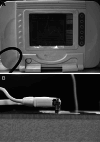Influence of different implant materials on the primary stability of orthodontic mini-implants
- PMID: 23217360
- PMCID: PMC11916761
- DOI: 10.1016/j.kjms.2012.04.037
Influence of different implant materials on the primary stability of orthodontic mini-implants
Abstract
This study evaluates the influence of different implant materials on the primary stability of orthodontic mini-implants by measuring the resonance frequency. Twenty-five orthodontic mini-implants with a diameter of 2 mm were used. The first group contained stainless steel mini-implants with two different lengths (10 and 12 mm). The second group included titanium alloy mini-implants with two different lengths (10 and 12 mm) and stainless steel mini-implants 10 mm in length. The mini-implants were inserted into artificial bones with a 2-mm-thick cortical layer and 40 or 20 lb/ft(3) trabecular bone density at insertion depths of 2, 4, and 6 mm. The resonance frequency of the mini-implants in the artificial bone was detected with the Implomates(®) device. Data were analyzed by two-way analysis of variance followed by the Tukey honestly significant difference test (α = 0.05). Greater insertion depth resulted in higher resonance frequency, whereas longer mini-implants showed lower resonance frequency values. However, resonance frequency was not influenced by the implant materials titanium alloy or stainless steel. Therefore, the primary stability of a mini-implant is influenced by insertion depth and not by implant material. Insertion depth is extremely important for primary implant stability and is critical for treatment success.
Copyright © 2012. Published by Elsevier B.V.
Figures


Similar articles
-
Effects of gripping volume in the mechanical strengths of orthodontic mini-implant.Kaohsiung J Med Sci. 2017 Nov;33(11):578-583. doi: 10.1016/j.kjms.2017.03.010. Epub 2017 Apr 25. Kaohsiung J Med Sci. 2017. PMID: 29050676 Free PMC article.
-
Evaluation of mechanical strengths of three types of mini-implants in artificial bones.Kaohsiung J Med Sci. 2017 Feb;33(2):96-101. doi: 10.1016/j.kjms.2016.11.001. Epub 2016 Dec 10. Kaohsiung J Med Sci. 2017. PMID: 28137418 Free PMC article.
-
Comparison of stainless steel and titanium alloy orthodontic miniscrew implants: a mechanical and histologic analysis.Am J Orthod Dentofacial Orthop. 2014 Apr;145(4):496-504. doi: 10.1016/j.ajodo.2013.12.022. Am J Orthod Dentofacial Orthop. 2014. PMID: 24703288
-
Effect of mini-implant length and diameter on primary stability under loading with two force levels.Eur J Orthod. 2011 Aug;33(4):381-7. doi: 10.1093/ejo/cjq088. Epub 2010 Nov 9. Eur J Orthod. 2011. PMID: 21062964
-
Miniscrew implant applications in contemporary orthodontics.Kaohsiung J Med Sci. 2014 Mar;30(3):111-5. doi: 10.1016/j.kjms.2013.11.002. Epub 2013 Dec 8. Kaohsiung J Med Sci. 2014. PMID: 24581210 Free PMC article. Review.
Cited by
-
Mini-implant stability at the initial healing period: a clinical pilot study.Angle Orthod. 2014 Jan;84(1):127-33. doi: 10.2319/040813-271.1. Epub 2013 Jul 24. Angle Orthod. 2014. PMID: 23883287 Free PMC article.
-
Effects of low-level laser therapy on orthodontic miniscrew stability: a systematic review.Eur J Med Res. 2023 Jan 27;28(1):50. doi: 10.1186/s40001-023-01010-z. Eur J Med Res. 2023. PMID: 36707888 Free PMC article.
-
Anchorage and Stability of Orthodontic Mini Implants in Relation to Length and Types of Implants.Cureus. 2024 Nov 5;16(11):e73056. doi: 10.7759/cureus.73056. eCollection 2024 Nov. Cureus. 2024. PMID: 39640137 Free PMC article. Review.
-
Reliability of Orthodontic Miniscrews: Bending and Maximum Load of Different Ti-6Al-4V Titanium and Stainless Steel Temporary Anchorage Devices (TADs).Materials (Basel). 2018 Jul 5;11(7):1138. doi: 10.3390/ma11071138. Materials (Basel). 2018. PMID: 29976856 Free PMC article.
-
Insertion torque, flexural strength and surface alterations of stainless steel and titanium alloy orthodontic mini-implants: an in vitro study.Dental Press J Orthod. 2024 May 20;29(2):e2423282. doi: 10.1590/2177-6709.29.2.e2423282.oar. eCollection 2024. Dental Press J Orthod. 2024. PMID: 38775601 Free PMC article.
References
-
- Favero L., Brollo P., Bressan E.. Orthodontic anchorage with specific fixtures: related study analysis. Am J Orthod Dentofacial Orthop. 2002; 122: 84–94. - PubMed
-
- Moon C.H., Lee D.G., Lee H.S., Im J.S., Baek S.H.. Factors associated with the success rate of orthodontic miniscrews placed in the upper and lower posterior buccal region. Angle Orthod. 2008; 78: 101–106. - PubMed
-
- Meredith N., Book K., Friberg B., Jemt T., Sennerby L.. Resonance frequency measurements of implant stability in vivo. A cross‐sectional and longitudinal study of resonance frequency measurements on implants in the edentulous and partially dentate maxilla. Clin Oral Impl Res. 1997; 8: 226–233. - PubMed
-
- Huang H.M., Pan L.C., Lee S.Y., Chiu C.L., Fan K.H., Ho K.N.. Assessing the implant/bone interface by using natural frequency analysis. Oral Surg Oral Med Oral Pathol Oral Radiol Endod. 2000; 90: 285–291. - PubMed
Publication types
MeSH terms
Substances
LinkOut - more resources
Full Text Sources

